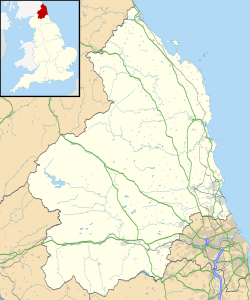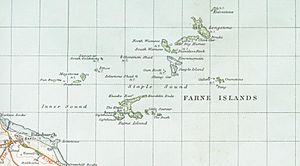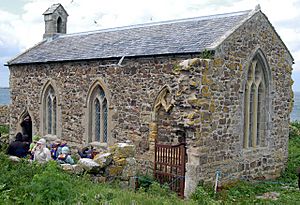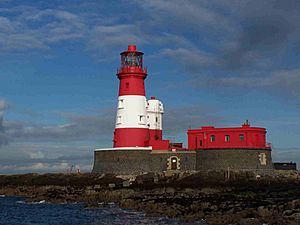Farne Islands facts for kids
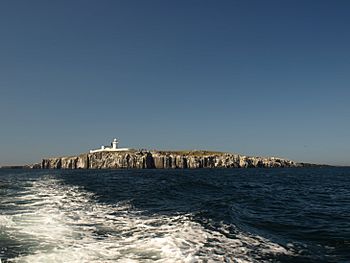
Inner Farne and its lighthouse: White bird droppings stain the cliff.
|
|
| Geography | |
|---|---|
| Location | North Sea |
| Coordinates | 55°37′19″N 1°37′41″W / 55.622°N 1.628°W |
| OS grid reference | NU235365 |
| Total islands | 20 |
| Administration | |
The Farne Islands are a group of small islands found off the coast of Northumberland, England. There are between 15 and 20 islands in the group, depending on how high or low the tide is. They are spread out from about 1.5 to 4.75 miles (2.4 to 7.6 km) away from the mainland.
The islands are split into two main parts: the Inner Group and the Outer Group. The Inner Group includes islands like Inner Farne and Knoxes Reef. The Outer Group has islands such as Staple Island and the Longstone. The highest point on the islands is on Inner Farne, reaching 62 feet (19 meters) above sea level.
Contents
History of the Farne Islands
Early Inhabitants: Monks and Hermits
The first people known to live on the Farne Islands were Christian monks called Culdees. They followed an old Celtic Christian tradition of living alone on islands. This tradition was also common in places like Wales, Ireland, and Scotland.
The islands were first mentioned in history in 651 AD. This is when Saint Aidan made them his home. Later, Saint Cuthbert lived there too. Saint Cuthbert chose to live by himself on the islands. He left for a short time to become a bishop, but he soon returned to the quiet life on Inner Farne. He died there in 687 AD.
Saint Cuthbert was very special because he created laws in 676 AD to protect the eider ducks and other seabirds nesting on the islands. These are thought to be the first bird protection laws in the world! After Cuthbert, Saint Aethelwold lived on the islands.
Hermits continued to live on the islands off and on for many centuries. The last hermit, Thomas De Melsonby, died there in 1246.
Monks and New Owners
Around 1255, a group of Benedictine monks set up a small monastery on the islands. It was linked to Durham Abbey, which is now Durham Cathedral. Usually, only two monks lived there, but sometimes there were as many as six. This monastery was closed in 1536 by King Henry VIII. This was part of his plan to close down monasteries across England.
After the monastery closed, the islands became property of Durham Cathedral. They were then rented out to different people. The Farne Islands were part of County Durham until 1844. Then, a law moved them to Northumberland. In 1861, Charles Thorp bought the islands. Later, in 1894, a rich businessman named William Armstrong, 1st Baron Armstrong bought them. Today, the islands are owned by the National Trust, a group that protects special places.
You can still see parts of the old hermit cells used by Saint Aidan and Saint Cuthbert. There are also remains of a chapel from the 1300s, called St Cuthbert's Chapel.
Grace Darling: A Heroic Rescue
The Farne Islands are famous for the brave story of Grace Darling. She was the daughter of William Darling, who was the lighthouse keeper at Longstone Lighthouse on one of the islands.
On September 7, 1838, when Grace was 22 years old, a ship called the Forfarshire crashed onto Harcar Rock during a terrible storm and thick fog. Grace and her father bravely rowed out in a small boat. They rescued nine people from the sinking ship. Their heroic act became very famous across Britain. Grace Darling became a national heroine, a true legend in British history.
The Farne Islands Today
No one lives on the Farne Islands permanently anymore. The only people who stay there are assistant rangers from the National Trust. They live in an old stone tower on Inner Farne and a lighthouse cottage on the Brownsman island. The stone tower was built around 1500.
Lighthouses of the Farne Islands
The first lighthouse on the islands was built in 1773. Before that, there might have been a simple light on Prior Castell's Tower as early as 1669.
Today, two lighthouses are still working on the Farne Islands. They are managed by Trinity House, the official lighthouse authority in England:
- Farne Lighthouse was built in 1811. It was first called Inner Farne Lighthouse.
- Longstone Lighthouse was built in 1826. It was first called Outer Farne Lighthouse. This is the lighthouse where Grace Darling lived.
Over the years, other lighthouses were built and later closed. For example, a lighthouse on Staple Island was destroyed in a big storm in 1784. Another one on Brownsman Island was replaced and then closed when Longstone Lighthouse opened.
All the lighthouses on the Farnes now work automatically. They don't need people living in them anymore. However, you can still see the ruins of some of the older lighthouses. The white streaks on the cliffs are not just bird droppings. They are also from old calcium carbide used to make light in the lighthouses before electricity was available.
Wildlife and Nature on the Farne Islands
The Farne Islands are a very important place for wildlife. Many people visit them by boat, especially in the warmer months. Local boats can land passengers on Inner Farne, Staple Island, and the Longstone. Landing on other islands is not allowed to protect the animals.
Amazing Birds
At the right time of year, you can see many puffins on the islands. They are very popular with visitors. On Inner Farne, Arctic terns nest close to the paths. They might even try to peck visitors who get too close, so wearing a hat is a good idea!
Some islands also have rabbits. They were brought there long ago for food and now live in the wild. Interestingly, rabbits and puffins sometimes share the same burrows. Puffins are strong enough to kick the rabbits out when it's their nesting season!
The Farne Islands are home to many different kinds of birds. Here are some of the birds that breed there:
- Shelduck
- Mallard
- Common eider
- Fulmar
- Cormorant
- Shag
- Oystercatcher
- Herring gull
- Lesser black-backed gull
- Ringed plover
- Black-headed gull
- Black-legged kittiwake
- Sandwich tern
- Roseate tern
- Common tern
- Arctic tern
- Guillemot
- Razorbill
- Puffin
- Barn swallow
- Pied wagtail
- Rock pipit
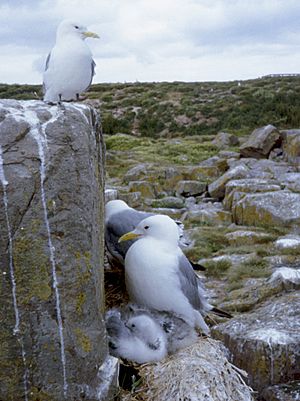
More than 290 different bird species have been seen on the Farnes. This includes a great auk in the 1760s, a bird that is now extinct.
Unusual Bird Visitors
The Farne Islands have also had some very rare bird visitors. In 1979, an Aleutian tern visited. This bird normally lives in the North Pacific Ocean. It was the first and only time this type of bird has ever been seen in Europe!
Another unusual visitor was "Elsie," a lesser crested tern. She came to the Farnes every summer from 1984 to 1997. She even had hybrid chicks with a male Sandwich tern. "Elsie" usually nests off the coast of Libya. It's thought she took a wrong turn at the Straits of Gibraltar!
A young Arctic tern from the Farnes, which was tagged in 1982, flew all the way to Melbourne, Australia, in just three months. This journey was over 13,670 miles (22,000 km)! It's one of the longest known distances any bird has ever traveled.
Seals of the Farne Islands
The islands are also home to a large group of about 6,000 grey seals. Several hundred baby seals are born there every year between September and November. These seals are very curious and often swim close to divers.
Geology of the Islands
The Farne Islands are made of strong, dark rock called dolerite. This rock is very tough. Long ago, these rocks were connected to the mainland. Over time, the softer rocks around them wore away. Also, the sea level rose after the last ice age. This left the dolerite rocks standing as islands.
Because of how the rock breaks, it forms tall, strong columns. This gives the islands their steep cliffs. The sea around the islands also has many tall rock formations called stacks, some as high as 66 feet (20 meters). Many of the smaller islands are just bare rock. But the larger islands have a layer of clay and peat soil, which allows plants to grow.
Shipwrecks and Diving Adventures
The Farne Islands are a popular spot for people who love to watch birds. They are also a great place for scuba diving. There are many different dive sites for all skill levels. Divers can explore the underwater world with the curious grey seals and discover old shipwrecks.
Hundreds of ships have been wrecked on the Farne Islands over the years. This makes it an exciting place for wreck divers. Here are a few examples of famous shipwrecks found there:
- The Chris Christenson, a Danish steamship, sank in 1915. It lies near the Longstone island.
- The Abessinia, a large German steamship, crashed in 1921. It rests in about 30 to 66 feet (9 to 20 meters) of water.
- The Brittania, a British cargo ship, hit rocks in thick fog in 1915. It lies between 26 and 98 feet (8 and 30 meters) deep.
- The St Andre, a French steamship carrying pig iron, sank in 1908. It can be found in about 56 to 82 feet (17 to 25 meters) of water.
Diving at the Farnes is often possible no matter which way the wind is blowing, as there's always a sheltered spot. Some dive sites even let you combine diving with birdwatching. For example, at a spot called the Pinnacles, you can see guillemots fishing while you are doing your safety stop!
Images for kids
-
Black-legged kittiwake (Rissa tridactyla) at nest on Staple Island
See also
 In Spanish: Islas Farne para niños
In Spanish: Islas Farne para niños


